Elderand is a dark fantasy non-linear platformer that tells the story of a bounty hunter who is hired to kill Sserthis, the vicious “tyrant of the sands.” I play as the Hunter after he arrives in Elderand via shipwreck, guiding him in search of his quarry. His situation immediately becomes more complicated than a bounty hunt: Elderand’s cities, strongholds, and countryside overflow with dangerous monsters and most of its human population are devoted to an evil cult who have lured the Hunter there with devious intentions. The Hunter comes to kill Sserthis; getting out alive is another quest entirely.
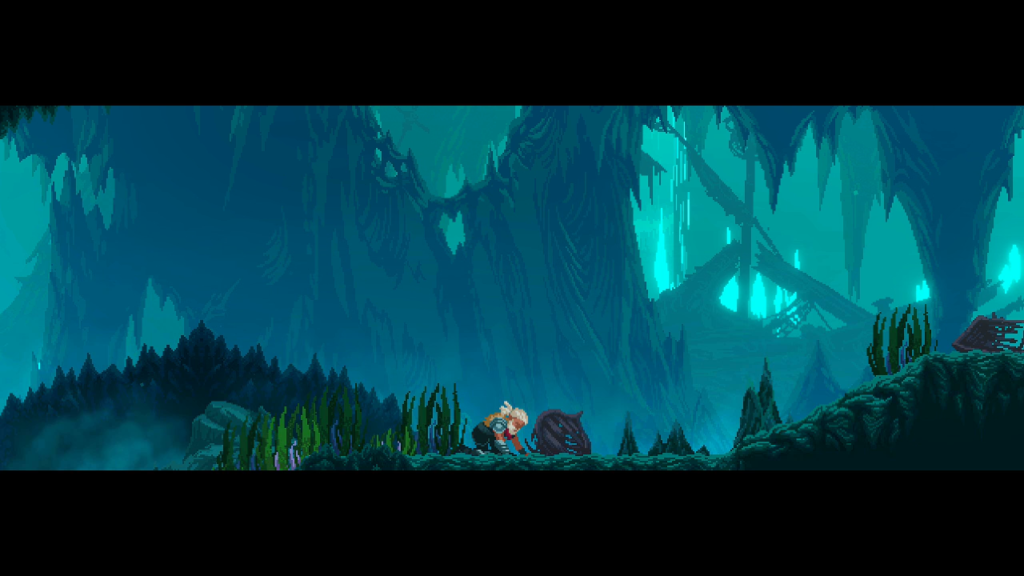
Elderand does little to grow beyond the expectations of the non-linear platformer. Following a brief opening cutscene, the Hunter wakes up on a murky shore in a place colorfully called Delinquent’s Breach. From here we begin to explore the side-scrolling open world environment, jumping up and down platforms to reach passages to adjacent rooms and killing monsters with a sword.
During the search for Sserthis, we defeat powerful monsters protecting magical treasures that expand the Hunter’s movement abilities. Once he can double jump, air dash, and swing from grappling hook targets, his mastery of the environment expands. By backtracking to previously explored areas and using these abilities, he can access new areas with new challenges and new treasures, whereupon the cycle repeats.
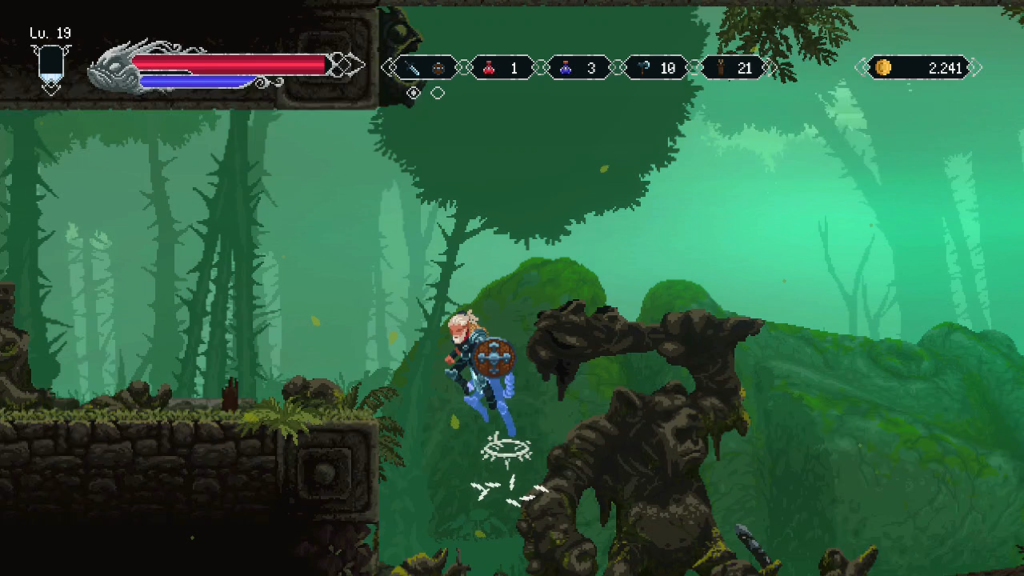
If I choose to linger in each area, the Hunter can apply these new movement abilities towards finding hidden artifacts that make him more powerful. The more of these artifacts we discover, the more powerful the Hunter becomes, translating exploration into character power in a direct and literal way. In Elderand, these artifacts come in the form of treasure chests. Some contain orbs that increase the Hunter’s magic and health pools, but most contain different forms of equipment.
In Elderand, you dress for the job you want. The Hunter begins his journey equipped with an ordinary sword, which we can soon pair with a shield. Shields can block many attacks, but only as long as the Hunter’s stamina holds out. Alternatively, we can eschew a shield and equip a dagger in each of his hands. He cannot block while dual wielding, but he can dodge enemy attacks with precise timing. For ranged combat, we can equip a bow and arrows or a magical stave to assault monsters from a distance. This is safer, but limited. The Hunter can only carry so many arrows, and which spell he casts depends on the stave he equips.
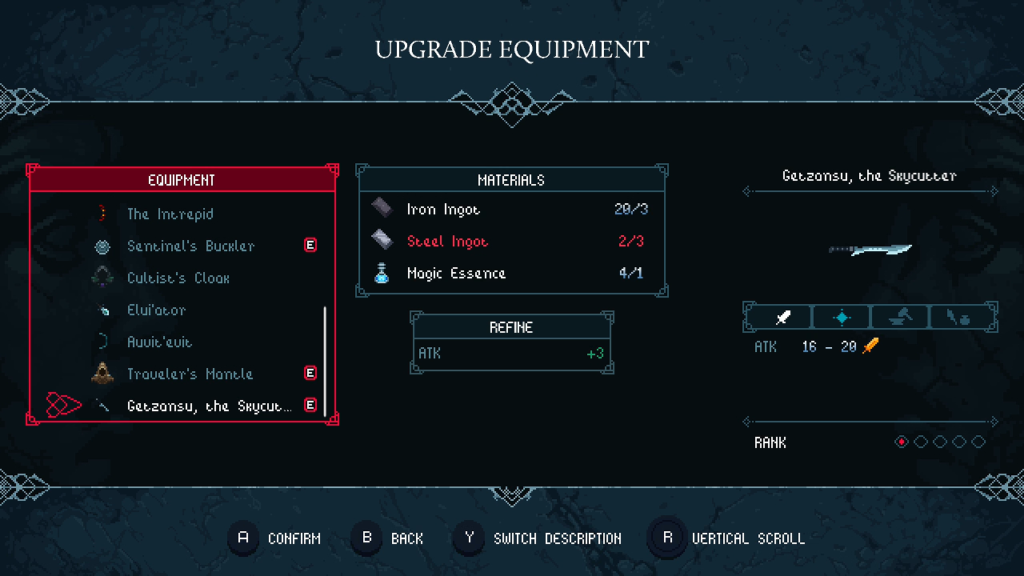
Equipment may be upgraded with the help of a friendly blacksmith who has taken refuge in Elderand’s last remaining village. Each weapon and armor piece may be upgraded multiple times, requiring materials that drop from specific monsters across Elderand. I didn’t find it difficult to fully upgrade everything equipped to the Hunter without having to grind for materials, but I also quickly fell into a comfortable and effective character build.
Elderand features an RPG character building system divided into four statistics. The system isn’t complicated. The Hunter earns experience points with each monster killed. Upon gaining enough experience points, he gains an experience level and can add a point to one of his key statistics. Strength increases the Hunter’s raw damage and boosts his stamina gauge. Dexterity increases his chance of a critical strike and damage with the sorts of weapons that can’t be used with a shield. Wisdom increases his magical damage and the mana gauge. Vitality increases his health.
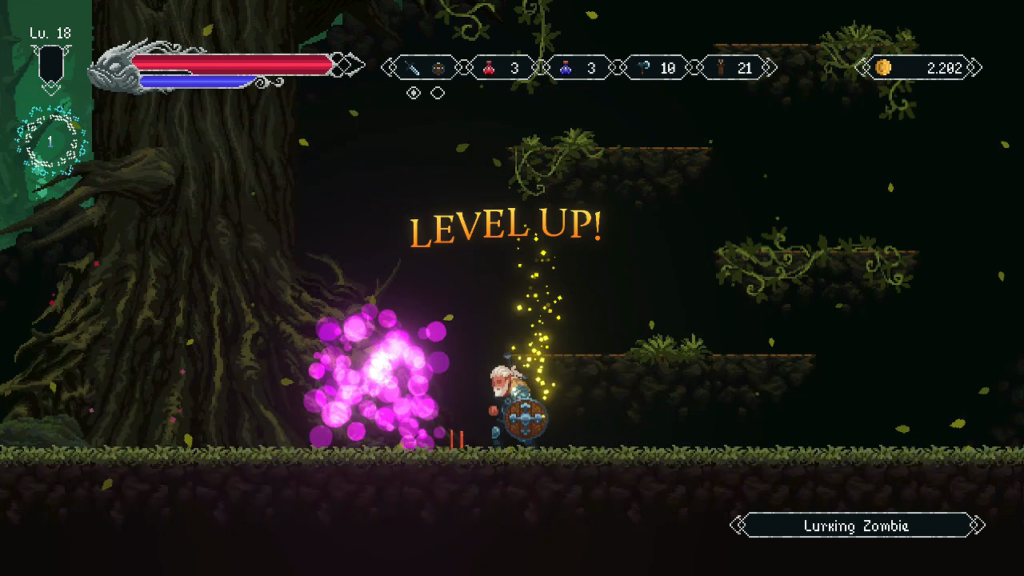
My stat distribution choices seem obvious to me: Get as much Vitality as I need to get by, and put everything else into the type of weapon damage I favor.
An advantage to these RPG systems is I could choose to replay Elderand favoring a different weapon style and have a markedly different combat experience. For the playthrough that accompanies this review, I settle on Strength and Vitality as the Hunter’s core statistics. I enjoy the straightforward attacking style of his sword weapons and absorbing attacks with his shield.
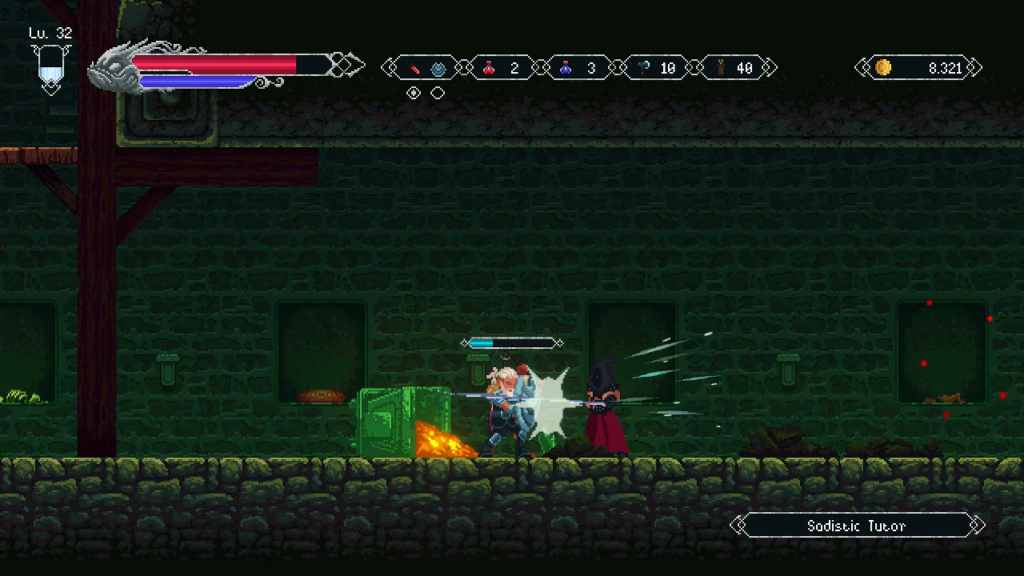
Somewhat arbitrarily, I build the Hunter’s Strength and Vitality at a 2:1 ratio. I typically fail at effectively distributing character statistics in RPGs, but to my astonishment I find this ratio takes Elderand’s mild difficulty and breaks it. The Hunter deals so much damage so quickly with his beefed up Strength stat that I am able to defeat most bosses by standing next to them and mashing the attack button, chugging healing potions as needed.
In the best non-linear platformers, quick and decisive movement is as important in combat as it is in traversing the world. In Elderand, even a sluggish lump can take on the Hunter’s enemies without difficulty. They aren’t dangerous enough to be a threat.
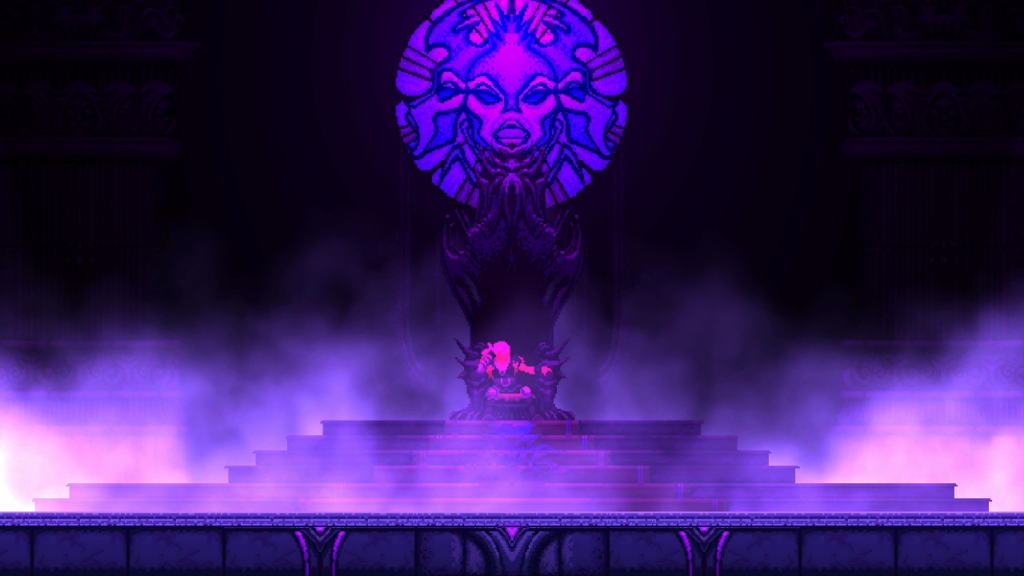
Elderand is also typical among non-linear platformers in having multiple endings. If I make a beeline straight for the final boss, I will get the bad ending. If I ignore the ominous doorway beckoning me to this red herring encounter, I can take the Hunter into the deepest parts of the world where we find the clues and the tools needed to reach the good ending. The fake final boss is bypassed through some game design trickery and the Hunter arrives at a much more satisfying conclusion to his journey.
Elderand executes this conceit no less competently than any other non-linear platformer I could name, but it feels like an obligatory inclusion. It’s here because it’s expected to be here, not because it adds anything to its narrative design.
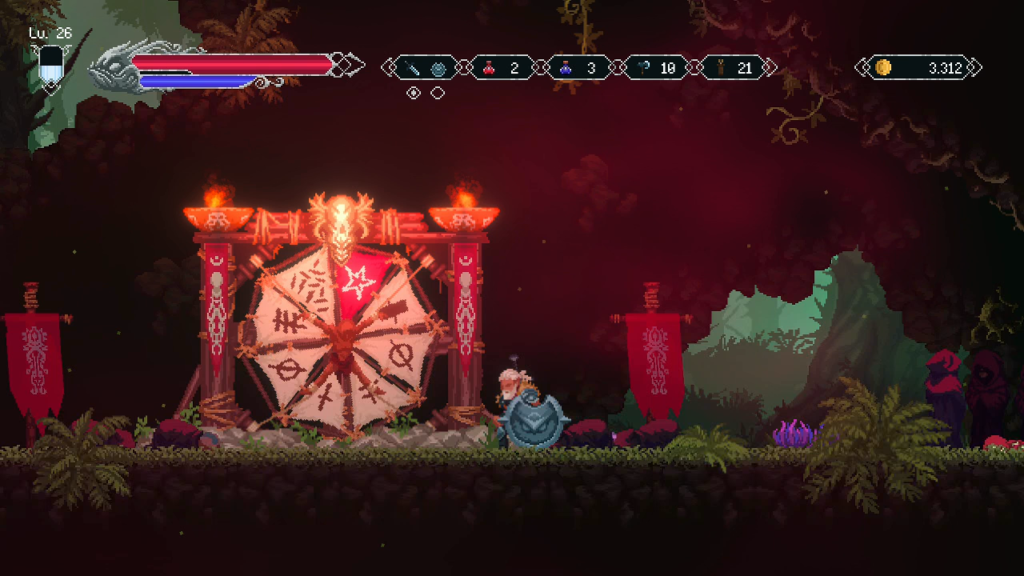
Only Elderand’s occasional cruelty makes it stand out among the glut of indie non-linear platformers. In multiple places across the world, I find the cult engaged in the torture and mutilation of a prisoner. Instead of freeing these prisoners from the obviously-evil and antagonistic cult, for some unexplained reason the Hunter can participate in these bloody rituals and earn a stat-increasing ring from the sacrifice.
If I am meant to feel conflicted about directing the Hunter to trade a human life for a magical trinket, I never do. Elderand doesn’t trouble itself with making me feel bad about these murderous transactions. Each encounter is forgotten as soon as it happens. Even an especially macabre ritual where the prisoner’s fate is decided by a crude spinning prize wheel ends up being more amusing than horrifying. Each ritual encountered is so sudden and ridiculous that it fails to elicit any feeling from me whatsoever.
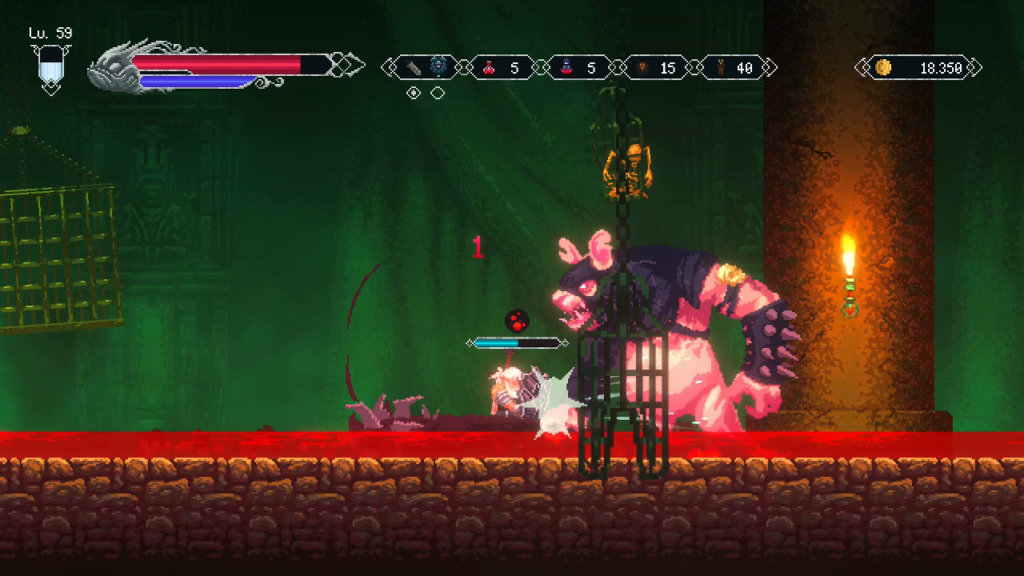
Where Elderand does fail to stand at least shoulder-to-shoulder with other indie non-linear platformers is in its world design. The world the Hunter explores is laid out mostly to the left and right. Long hallways filled with monsters to kill typify areas as nominally disparate as the Forest of the Exhausted and Akr-Sharrak, the Sanctuary of the Tyrant Hope. There is little to explore, and it makes running back and forth between areas tedious. The world feels stretched, like it was laid across a baker’s table and flattened with a rolling pin.
The result is Elderand lacks any sense of density. There are few paths to interconnect most areas; if I want to guide the Hunter to another important location, it usually means running to the far left or far right side of the world. I subsequently lean hard on a save point fast travel system to get around. This is a non-linear platformer where there’s little satisfaction in traversing the world. It misses the point of non-linearity in a non-linear platformer.
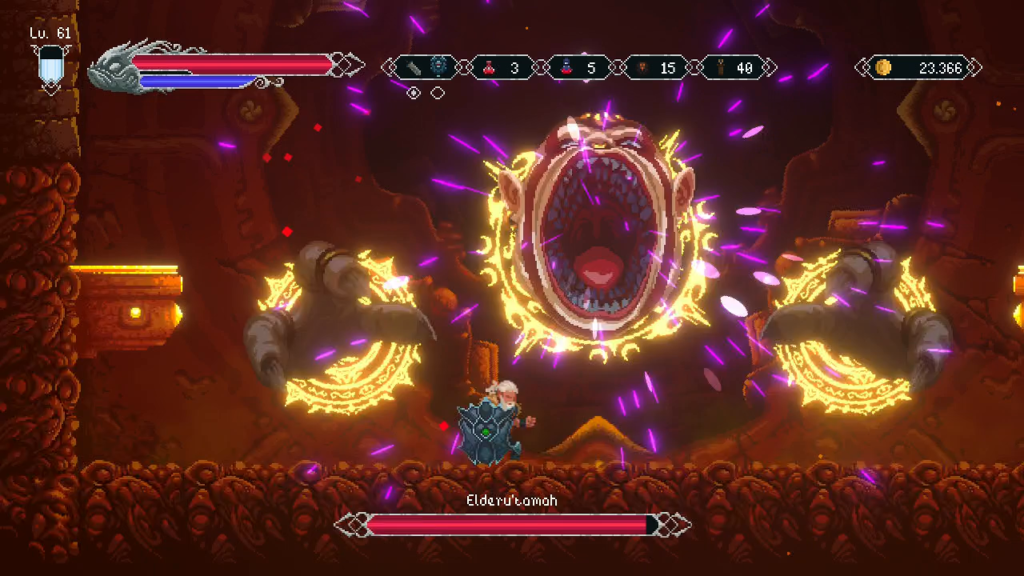
Elderand is a competent non-linear platformer whose main problem is it does little to subvert my expectations or upset my complacency. If I were to list its many features, they would feel like checkmarks of genre conventions. I would struggle to list any features that aren’t found in any other videogame like it. For a genre this crowded, this is a death mark. The experience isn’t completely rote; the different weapon styles suggest some replay value. A stretched, incohesive world makes this an unwelcome prospect. Elderand isn’t a bad non-linear platformer. It’s forgettable. For a videogame, this is often a worse fate.